Creating an alternative world: What is the ideal art museum architecture?
An architect who’s designed numerous art museums and a contemporary artist who brought us the photographic series Architecture and who’s recently branched out into design. Here, these two creatives, both active on the international stage, chat about architectural space from the perspective of a place to present artwork. So, just what is the ideal ‘box’ for art?
Text: ART iT
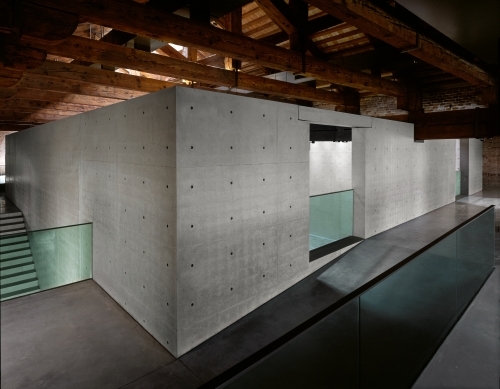
Ando Tadao Punta della Dogana
Central Court, the new main gallery set within the existing building interior
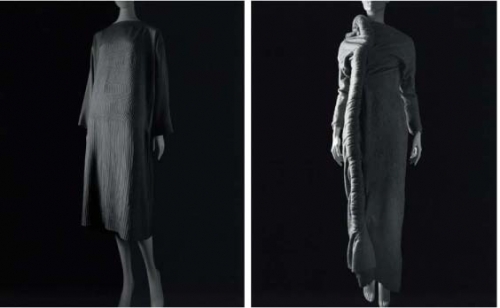
From left to right: Sugimoto Hiroshi Stylized Sculpture 023, 020 2007 Gelatin-silver prints
©Hiroshi Sugimoto Courtesy Gallery Koyanagi
Sugimoto Hiroshi Over the years I’ve held various exhibitions at art museums built by famous architects from around the world. The Foundation Cartier pour l’art in Paris, which was designed by Jean Nouvel, the Royal Ontario Museum in Toronto, the extension to which was designed by Daniel Libeskind, the Neue Nationalgalerie in Berlin, by the great Mies van der Rohe, the Modern Art Museum of Fort Worth in Texas, which was designed by your good self, the 21st Century Museum of Contemporary Art, Kanazawa, designed by SANAA (Sejima Kazuyo and Nishizawa Ryue), and of course today’s venue, the National Museum of Art, Osaka, which was designed by César Pelli. In June, at the Punta della Dogana in Venice, the refurbishment of which you’re also in charge of, I’ll be unveiling a new series entitled Stylized Sculpture, which involves fitting items from the collection of post-1920s fashion held by the Kyoto Costume Institute to mannequins and photographing them as if they were sculptures.
However, as an artist, there are lots of things about architectural space designed by famous architects I find extremely difficult to use (laughs). So I’d like to get the ball rolling by asking you, as someone who’s actually involved in this kind of design work, to comment on this.
Are museums designed by famous architects difficult to use?
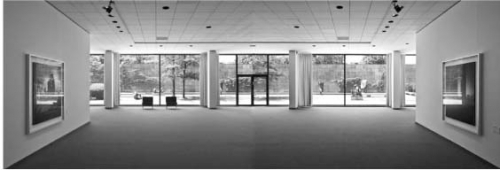
Installation view at Neue Nationalgalerie (Berlin) 2007
©Hiroshi Sugimoto Courtesy Gallery Koyanagi
Ando Tadao It’s been said that architects put a lot of effort into designing difficult to use boxes, and there may well be some truth in that. It’s probably because architects are completely absorbed in the actual building, and they may even think artists can achieve virtually anything with their exhibits (laughs).
Originally, art museums typically took the form of a series of small rooms, although recently a single room has become the norm. The first art museum to adopt this style was the Centre Pompidou, which was completed in 1977, the idea being that a single room allows greater freedom. The flip side of this is that you end up with what looks like a collection of artworks placed inside a shopping center, and so unless one displays a great deal of imagination, such buildings are difficult to use. Of the art museums you just mentioned, although it’s smaller in size, the Foundation Cartier pour l’art is also a single room museum.
In the case of Mies van der Rohe’s Neue Nationalgalerie in Berlin, too, I don’t think there’d be many artists capable of creating work that could be displayed in such a massive space. So from Mies’s perspective, I suspect he only intended it to be used for exhibitions once every ten years. And in fact there haven’t been that many good exhibitions there since it opened, have there?
SH In the final analysis, it just costs too much, doesn’t it? Even if you put up walls, they’re only temporary. And even with sculpture, there are very few sculptors capable of creating work that could be plopped down in the middle of such a vast space and not be overwhelmed by the space.
AT Speaking of the cost of architecture, I have a funny story. The most famous building by Antoni Gaudí is the Sagrada Família. Well, Le Corbusier went to see some other work by Gaudí. Gaudí also built a school where he himself invited students to study and a building resembling a small church, and because he built these using his own money, you can see at a glance that they’re low cost. Le Corbusier said he liked these two buildings the best. He was really only interested in these and the Sagrada Família, which was only partly completed. He liked the fact that it was unfinished. The other two he liked because they were really low cost. As you’d expect from a great architect, he had a great eye.
In the case of the Sagrada Família, being a man with such a powerful imagination, Gaudí was constantly making changes to it as the building progressed. They’ve started work on it again now, adding new things as it nears completion, and it will probably end up looking completely different. The man from whose imagination it grew has passed on, so I think it’d be best not to work on it any more but to leave it unfinished.
SH I went there myself with the intention of photographing it, but I gave up. The original parts that were completed while Gaudí was alive are beautiful, but the more they’ve added to it the less interesting it’s become.
AT Daniel Libeskind, whose name cropped up before, also built the Jewish Museum in Berlin. When I saw it there were no exhibits inside, and I thought it was wonderful, but as they’ve put more and more contents and filled it with exhibits, it’s become somewhat commonplace.
SH It’s turned into a completely dull space, hasn’t it? It was probably the original intention of the architect that it wouldn’t have exhibits, thereby serving as a perpetual reminder of the holocaust.
AT I think so.
SH Now that it’s full of exhibits, it’s turned into something on the same level as an erotic museum (laughs).
On site, Japan isn’t so bad after all
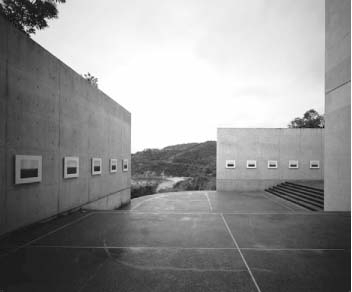
Installation view at Benesse Art Site Naoshima 2006
©Hiroshi Sugimoto Courtesy Gallery Koyanagi
AT Fukutake Soichiro, who’s the chairman of the Benesse Corporation, is building all kinds of facilities to showcase contemporary art on the island of Naoshima in the Inland Sea. I’ve helped with several of these, including the Chichu Art Museum, and three years ago I designed some wooden structures for the hotel there. You were given the opportunity to design your own gallery, and when the outline was more or less complete, you showed it to me. I thought it was really great, because you’d come up with this alternative world that was quite separate from the architecture we’d designed. I think an artist exhibiting their own work is the equivalent of them creating an alternative world.
SH The hotel structures on Naoshima were designed by you as a coherent space, but the people who use them are not really aware of this. They have this wonderful space, yet they’ve filled it with furniture that’s neither here nor there. I think Fukutake-san also wanted to do something about this. So he said to me, “You handle it.” But if I agreed, I’d have to make changes to the detail you’d designed. I wasn’t sure I could cope with such a daunting task, so I went to your office and we talked it over, and we came up with something we both agreed would work. Space continually needs to change to accommodate the artwork placed in it, right? So I created a seven-meter-long light box to accommodate the work. The bottom is made of metal, while the other five sides are all covered with glass, the concept being a giant azuki-bean jelly that has been cut open and filled with lighting apparatus. For the shape of the jelly, I borrowed the shape of the seven-and-a-half-meter-long narrow slit window you designed for the entrance lobby and reproduced this in its entirety, including the light, and placed it on the floor. This was out of respect to your architecture, or rather so I had an excuse if you complained about it (laughs).
AT Artists have incredibly delicate feelings, whereas architects tend to be a bit tougher, so I just said, “OK, I see” (laughs). It’s not as if you’re extending and rebuilding the place, and continually changing the exhibition space means you’re creating an alternative world there and that the people who come to see it get to see a different world, so I thought it was great.
For next year, Fukutake-san is talking about doing an island-hopping art exhibition that will take people all around the Inland Sea from Naoshima, to Teshima, to Inujima, and even to Takamatsu, so I thought I had to do something to acknowledge his efforts. He’s really passionate when it comes to art, and he mentioned how the number of patrons who offer people like us the opportunity to work has declined recently. Were there more such people before?
SH No, there’ve never been that many. There are a lot more overseas. Bono, who’s responsible for turning the Punta della Dogana into an art museum, is one of the world’s great art collectors. In Japan, there were more patrons before the war, like the Mitsui zaibatsu.
Japan has achieved an equal society, so much so that in a sense you could say it’s the country where socialism has progressed the farthest. People say the US is a democracy, but there’s no other society where the gap between the rich and the poor is as great. But the larger the gap between the rich and the poor, the more great wealth is concentrated in the hands of a few individuals. These individuals then create art museums partly to satisfy their own tastes. As a rule, art museums in the US are nearly all private, with the Smithsonian being the only national museum. The Metropolitan Museum of Art and New York’s MoMA are both the result of wealthy individuals collecting art and establishing art museums as a way of showing off how culturally superior their own cities are. New York’s art museums can’t be worse than those in Chicago or Boston. That’s the kind of competitive spirit from which these places arise.
Until the 19th century and early 20th century, people who became superrich donated their money to the church. However, god’s authority has become so weak that regardless of how wealthy one becomes, one no longer gets the same sense of satisfaction, the sense of remission, the sense that one is doing something really worthy as a result of donating this wealth to the church. So instead these people donate the art they’ve collected to museums. In a sense art museums have become substitutes for religion.
This kind of awareness is another thing that’s lacking in Japan. Which is why there’s no reason to begin with why people would even consider collecting artworks. In Fukutake-san’s case, he picked artists like Walter De Maria and James Turrell based on his own judgment and commissioned work from them. I think it’s wonderful that such a non-stereotypical Japanese person has suddenly appeared.
Having worked on Naoshima, the thing that makes me think Japan isn’t so bad after all is the feeling on site amongst the people who actually construct the buildings. There’s a group of tradespeople within Kajima Corporation – let’s call them Ando-gumi – who’re assigned to you and who’ve worked with you for the past 20 years. Whenever you want to do something or change something in one of your spaces, all you have to do is say so and provide a simple drawing and these people will think about what needs to be done from various angles and judge based on their experience that you wouldn’t approve if they did so-and-so or I probably wouldn’t like it if they did so-and-so, as a result of which rapid progress is made. On the other hand, they also come up with comments like “We’ve put an Ando-style window in here” (laughs). It’s an architect’s job to consider the broad outline and leave the rest up to the people on site. On-site judgment is also extremely important, isn’t it?
AT In the case of the Kajima people with whom I work on Naoshima, I work with them not as inferiors or superiors but as members of the same team. We all work together with the same goals. Once the outline is more or less decided, the rest is determined on the basis of discussions on site. When it comes to technical standards, no country beats Japan.
SH The results are better if they’re just left to get on with it, aren’t they?
AT The results are better if they’re just left to get on with it. I’ve also worked in Venice for the past 20 years. I thought I couldn’t do it on my own, so I thought I’d put together a team. Mechanical engineers, structural engineers, plasterers, carpenters. Twenty years ago I put together a team of around 25 people who’re now working on their sixth project in Venice, and all I need to do now is make a drawing with a certain level of detail and send it to them and they say, “Leave it to us” (laughs). From time to time they come to Japan, and we also go over there to work with them, but we always work as a team, with everyone thinking about what they themselves can contribute.
What makes an enduring image?
AT A while back, for no particular reason I decided to go and see the rock garden at Ryoanji temple early in the morning, and as I was lying on the veranda alone a feeling of happiness washed over me. When I look at your Seascapes, I experience a similar feeling, in other words I sense a kind of happiness.
SH By the far the vast majority of people who bought those photographs hung them in their bedrooms. If you gaze intently at them before you go to sleep your mind becomes calm and you sleep better. You can look at them everyday without getting sick of them, and in fact you grow to like them even more. That’s something quite unusual among contemporary art.
It comes down to a question of what makes an enduring image, of what makes a strong image capable of existing in defiance of the passage of time. For a long time now I’ve been photographing contemporary architecture by people like Le Corbusier, and I’ve taken to doing a kind of durability test that involves taking intentionally out-of-focus shots and seeing whether or not buildings have the power to hold up in the face of these out-of-focus images. A lot of modern buildings dissolve to the point where nothing remains when you shoot them this way.
I think my photographs are more beautiful than the buildings themselves. I know I can’t really speak on behalf of architects, but they probably think their buildings are at their most beautiful when they’re first visualized in their heads. As time goes by, the clients and the builders and the budgets come into play, and as they’re told they can’t do this, or they can’t do that, or you’ll have to change this, this initial vision changes and turns into something more realistic. So I think those sketches you occasionally draw on napkins are probably the most ideal form for what you have in mind, aren’t they?
AT Various factors certainly come into play. In my case I established my own firm when I was in my late-20s, and until I was 35 or 36 I thought I didn’t need to pay any attention whatsoever to things like budgets or the opinions of my clients. Of course I told them they were free to make any comments, but in fact I had no intention of doing it any way other than how I wanted to do it. When I was young I was building small houses with a total floor space of around 30 tsubo (roughly 100 sq. meters), so I could get away with it. Having a small budget is actually a blessing. The fact the budget is small also weighs on the conscience of the client, so you can do what you please. In situations like that, you often end up with interesting results.
But it’s different with your photographs. They’re art, so from the outset people around the world can’t see anything other than at the level of a virtual world, can they? Recently, U2’s Bono put out a new album, and the photo on the jacket is from your Seascapes series, which I thought was amazing. Actually, fives years ago Bono came to me and said, “Ando-san, let’s do something together to help the refugees.” I’m from the generation that grew up listening to The Beatles, so I didn’t know who Bono was. So I said, “No thanks,” but the people I work with said he was an interesting guy, so I decided to meet him, and we went to the Church of the Light together. He asked if he could sing a song, and when I said yes he sang “Amazing Grace”, and I was taken aback and thought, This old guy can really sing (laughs). That’s how we got to know each other, and now I’m designing Bono’s house in Dublin.
SH It’s less then two months since it was released, yet five million copies have already been sold. It’s still continuing to sell everyday.
I was invited out of the blue to Bono’s villa in the south of France. I didn’t know much about him. I spotted this familiar-looking old guy and it turned out to be Bono. He told me he really liked my seascape work and that he wanted me to photograph the view of the Mediterranean from his villa. “Thank you,” I replied, “but I’ve never taken photographs at anyone’s request, so I’m going to have to say no.” Then we got talking and kind of hit it off, and we even ended up writing some music and lyrics together. So it was kind of automatic that that photo ended up being used on the jacket…
But when it’s something that sells five million copies, all these hoards of commercial types start to appear. And when people like that get involved, the friendliness breaks down. I started getting asked things like how much I’d sell the copyright on that photo for. I couldn’t be bothered with all that, so we decided to do it like bartering in the Stone Age, so that he was free to use my images, but in exchange I would have the right to freely use his music. So we came up with this beautiful concept in which no money changed hands at all. In defiance of capitalism, we agreed that we’d do this exchange because we were friends, with no involvement from the taxman or anyone else. I think it’s a really great relationship.
AT In architecture, we always say we’ll do this and that but we end up building square boxes. Difficult-to-use square boxes. And then someone like you turns up, or Bono turns up, or Damien Hirst turns up. Because I’m also designing a house for Damien Hirst.
SH Is that right? Well, make it as difficult to use as possible please (laughs).
The problem with Japanese art museums
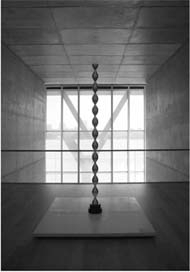
Installation view at Modern Art Museum of Fort Worth 2006-07
©Hiroshi Sugimoto Courtesy Gallery Koyanagi
SH Lastly, I’d like to ask you a question. The Modern Art Museum of Fort Worth, which you designed, involved placing this huge building right in the middle of Texas, but it’s relatively easy to use and only cost around five billion yen to build. At around the same time you built the Hyogo Prefectural Museum of Art in Kobe, which is around the same size, didn’t you?
AT Twenty-five billion yen.
SH That means it costs five times as much to build something in Japan. In terms of scale, they’re about the same, aren’t they?
AT The museum in Kobe was slightly larger, but as a rule construction costs in Japan are around double what they are in the US.
SH Where does all the money go?
AT For a start, everything is more expensive in Japan. On top of that, the construction period for public works projects is extremely long. Around twice as long as in the US.
SH You’d think there’d be plenty of aspects that could be streamlined, wouldn’t you? Can’t something be done about that?
AT It’s not easy. After all, we’re talking about public works projects. But we all have to do something about creating a less wasteful society. In reality, we have to think carefully about culture whenever we use anything. In that sense, we need to spend more of our budgets on things like exhibitions and operations.
Something I’ve been saying repeatedly for the last 20 or 30 years is that people should halve the amount they spend on buildings, so if it’s 10 billion they should spend five billion on the building and devote the rest to operating expenses. But when I suggest this I’m told it’s something I don’t have a say in, that allocating the budget is not my business so they can’t do that. I think this is something that’s really enfeebling cultural facilities in Japan. Art museums are nothing more than boxes, and additional funds are needed to hold the actual exhibitions. However, there isn’t the money for this. This is the biggest problem with Japanese art museums.
This conversation took place on 19 April 2009 at the National Museum of Art, Osaka in conjunction with Hiroshi Sugimoto: History of History.
Ando Tadao
Born 1941 in Osaka. Self-educated in architecture, he established Tadao Ando Architect & Associates in 1969. Received the 1979 Architectural Institute of Japan Prize for his Row House in Sumiyoshi, thereafter honored with the Alvar Aalto Medal, Pritzker Prize, UIA Gold Medal among many others. Major works include the Church of the Light (Osaka), Pulitzer Foundation for the Arts (St. Louis), Modern Art Museum of Fort Worth, Chichu Art Museum (Naoshima), and 21_21 DESIGN SIGHT (Tokyo). He has also taken a leading role in social causes including reconstruction efforts following the Great Hanshin-Awaji Earthquake, work with the Setouchi Olive Foundation, the Sea Forest project, and as head of the Tokyo Olympic Bidding Committee advocating an eco-aware Olympic concept. Visiting professor at Yale, Columbia, and Harvard Universities; professor at the University of Tokyo 1997-2005, where he is currently professor emeritus. Author of Tadao Ando Houses & Housing and the subject of numerous monographs. His solo show Tadao Ando ‘Aqua Metropolis Osaka’ runs through July 12 at the Suntory Museum (Osaka).
Suntory Museum (Osaka)
http://www.suntory.co.jp/culture/smt/gallery/index.html
Sugimoto Hiroshi
Born 1948 in Tokyo. After graduating Rikkyo University in 1970 with a degree in economics, studied photography at the Art Center College of Design in Los Angeles. Moved to New York in 1974. In parallel with his art practice, he collects and deals in antiques. Major photo series include Dioramas, Seascapes, Theaters, Portraits, Chamber of Horrors, In Praise of Shadow, Architecture, and Conceptual Forms. Winner of the 2001 Hasselblad Foundation International Award in Photography. His retrospective Hiroshi Sugimoto: End of Time staged at the Mori Art Museum (Tokyo) in 2006 subsequently toured the US, and his History of History showed at the National Museum of Art, Osaka in spring 2009. He designed the Go’o Shrine on Naoshima in 2002, and the architectural interiors for the New Material Research Lab, which he established the in 2008, and the Izu Photo Museum (scheduled to open September 2009). Author of Koke no musu made – time exposed and Utsutsu na zou, in addition to a number of photocollections.
Punta della dogana (Venice)
Ando Tadao was charged with renovating the government-owned customs house built in the 15th century into a contemporary art museum to display works from the François Pinault collection.
Opening exhiition Mapping the Studio
6.6?12.31
Curators: Alison Gingeras and Francesco Bonami
http://www.palazzograssi.it/index.php
A group exhiition scheduled to coincide with the Biennale showing simultaneously at the Palazzo Grassi. Sugimoto Hiroshi’s Stylized Sculpture is on exhiit at the Punta della dogana.
Originally printed in ART iT No.24 Summer 2009
